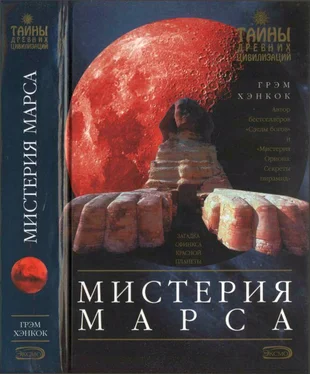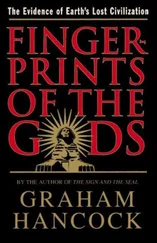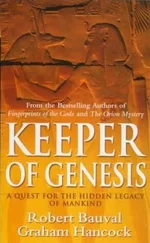21. Cattermole, Mars, 30; Encyclopaedia Britannica, 15 th edition, «Solar System».
22. Cattermole, Mars, 30.
23. Ibid, 134.
24. Ibid, 32.
25. Ibid, 22.
26. Ibid.
27. Ibid, 22, 72.
28. Ibid, 22,27.
29. Donald W. Patten and Samuel L. Windsor, The Scars of Mars (Seattle: Pacific Meridien Publishing, 1996), 12; Cattermole, Mars, 27.
30. Patten and Windsor, The Scars of Mars, 12.
31. Ronald Greely, Planetary Landscapes (New York: Chapman and Hall,1994), 155.
32. Giuseppe Filotto, The Face on Mars, 150. См. также Cattermole, Mars, 25.
33. Filotto, Face on Mars (Gardenview, South Africa: Exact Print, 1995), 150.
34. Cattermole, Mars, 60.
35. Greely, Planetary Landscapes, 175.
36. Melosh and Vickery quoted in John and Mary Gribbin, Fire on Earth: In Search of the Doomsday Asteroid (London and New York: Simon and Schuster, 1996), 77.
37. Ibid., 76.
38. Ibid, 79.
39. Hansson, Mars and the Development, 68ff.
40. Scientific American, November 1996.
41. Di Pietro and Molenaar, Unusual Martian, 60ff.
42. Ibid.
43. Carr, et al. An Exobiological Strategy for Mars Exploration, NASA, January 1995.
44. Ibid, 8–9.
45. Cattermole, Mars, 32.
46. Scientific American, November 1996.
47. Victor Baker and Daniel Milton, «Erosion by Catastrophic Floods on Mars and Earth», Icarus 23 (1974): 27–41.
48. Cattermole, Mars, 198.
49. Scientific American, November 1996.
50. Charleston Gazette, 8 July 1997.
51. Ibid.
52. Cattermole, Mars, 198; Murray, Malin, Greely, Earthlike Planets, 277–286.
5 3. Hansson, Mars and the Development, 41.
54. Ibid.
55- Ibid.
56. See chapter 2.
57. Cattermole, Mars, 130.
58. Astronomy Now, October 1996, 45–46.
59. Greely , Planetary Landscapes, 185.
60. Cattermole, Mars, 198; Greely, Planetary Landscapes, 185.
61. Координаты Сидонии см. Hoagland, Monuments of Mars, 16.
62. Hieronymous and Co. Newsletter, 14, 16.
Глава 4. Двуликая планета
1. К примеру, см. Gribbin, Fire on Earth, 74–75.
2. Encyclopaedia Britannica, 15th edition, «Solar System». «Марс движется вокруг Солнца на среднем расстоянии, примерно в 1,52 раза превышающем расстояние от Земли до Солнца. При максимальном сближении Марс находится на расстоянии 206600 000 километров от Солнца, а при максимальном удалении — на расстоянии 249 200 000 километров. Марс совершает один полный оборот вокруг Солнца примерно за два земных года, поэтому большую часть времени он находится вдали от Земли, особенно при сближении с Солнцем». Максимальное сближение Марса и Земли: 56000 000 километров. Максимальное удаление от Земли: 400 000 000 километров.
3. Cattermole, Mars, 191.
4. Carr, et al., Exobiological Survey, 233–234.
5. William K. Hartmann, «Cratering in the Solar System», Scientific American, January 1977,
6. George E. McGill and Steven W. Squires, «Origin of the Martian Crustal Dichotomy: Evaluating Hypotheses», Icarus 93 (1991): 386.
7. Ibid., Cattermole, Mars, 191.
8. Carr, et al., Exobiological Survey, 233–234.
9. Hartmann, «Cratering», 89; Arvidson, Goettel, et al., «A Vost-Viking V iew of Martian Geologic Evolution», Reviews of Geophysics and Space Physics 18 (August 1980): 575.
10. McGill and Squires, «Origin», 391.
11. Hartmann, «Cratering», 97.
12. L. A. Soderblom, C. D. Condit, et al., «Martian Planetwide Crater Distributions: Implications for Geologic History and Surface Processes», Icarus 22 (1974): 240.
13. Насколько нам известно, первыми серьезными исследователями этой проблемы были Паттен и Виндзор. См. Patten and Windsor, Scars of Mars.
14. D. S. Allan and J. B. Delair, When the Earth Nearly Died: Compellingßvidence of a Catastrophic World Change, 9500 B.C. (Bath, England: Gateway Books, 1995), 230.
15. Patten and Windsor, Scars of Mars, 18–19.
16. Ibid. См. также Patten and Windsor, The Recent Organization of the Solar System (Seattle: Pacific Meridien Publishing, 1997).
17. Icarus 36 (1978): 51–74.
18. Ibid., 51.
19. Greely, Planetary Landscapes, 155.
20. Patten and Windsor, Scars of Mars, 19–21.
21. Ibid.
22. Ibid.
23. Ibid, 30–31.
24. Cattermole, Mars, 56–58.
25. See part 4.
26. Mail on Sunday Review (London), 12 June 1994, 43.
27. Gribbin, Fire on Earth, 44; Encyclopaedia Britannica , 15th edition, Tunguska event.
28. Gribbin, Fire on Earth, 45; Mail Review, 43.
29. Gribbin, Fire on Earth, 47–48.30. Ibid, 30ff.
31. Ibid, 11–12.
32. Ibid, 1,12.
33. Encyclopaedia Britannica, 15th edition, «Solar System».
34. См. главу 4.
35. Gribbin, Fire on Earth, 32; Hartmann, «Crater», 86.
36. Gribbin, Fire on Earth, 32.
37. Patten and Windsor, Scars of Mars, 31.
38. Ibid.
39. Ibid, 37; Cattermole, Mars, 30.
40. Cattermole, Mars, 142.
41. Gribbin, Fire on Earth, 78.
42. Hartmann, «Crater», 97.
43. Men and Delair, When Earth Nearly Died, 205.
44. Ibid.
45. Hartmann and Larson, «Angular Momenta of Planetary Bodies», Icarus 7 (1967): 258; see also Fish, «Angular Momenta of the Planets», Icarus 7 (1967): 25Iff.
46. Allen and Delair, When Earth Nearly Died, 205.
47. «Large-Scale Variations in the Obliquity of Mars», Science 181: 4096,260ff.
48. Jihad Touma and Jack L. Wisdom, Scientific American, November 1996. Emphasis added.
49. «Large-Scale Variations», 205—6. См. также Cattermole, Mars, 9. У Марса слабое магнитное поле — всего лишь 0,03 % от земного.
50. Peter Н. Schultz, «Polar Wandering on Mars», Icarus 7Ъ (1988): 91-141.
51. Hartmann, «Crater», 89.
52. Ibid.
53. Patten and Windsor, Scars of Mars, 22.
54. Ibid., 69.
55. Allen and Delair, When Earth Nearly Died, 210.
56. Ibid.
57. Victor Clube and William Napier, The Cosmic Serpent (New York: Universe Books, 1982); and The Cosmic Winter (Oxford, England: Basil Blackwell, 1990).
58. Cm. Hartmann, «Crater», 89.
59. Cattermole, Mars, 175.
60. Filotto, Face on Mars, 151.
61. О возможности такой иллюзии см. Soderblom, Condit, et al., in Icarus 22 (1974): 234, где они отмечают, что любопытные характеристики марсианской дихотомии «создают впечатление, что марсианский ландшафт либо является очень древним и отражает ранний этап марсианской истории, либо очень молодым, возникшим на последнем этапе эволюции Марса».
Читать дальше


![Грэм Макнилл - Кузницы Марса [трилогия]](/books/25435/grem-maknill-kuznicy-marsa-trilogiya-thumb.webp)









